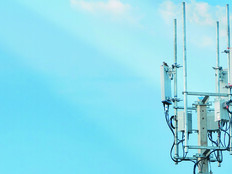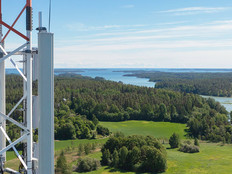How Can Smart Sensors Help Create Healthy Buildings?
Sensor data will likely play a key role in the safe reopening of federal spaces. Many smart controllers already can support a range of sensor capabilities in the HVAC system and throughout office spaces, and new data sources are emerging all the time as researchers look for ways to keep buildings ahead of the virus.
For COVID-19 management, one important measure is occupant density — how many people are in a given space. One emerging methodology would leverage cellphone signals as a means of occupant tracking.
“Your phone has a Wi-Fi transceiver, and it sends a signal all the time announcing its presence. We have a network of access points where we listen to that signal, do some triangulation and localize with 2-meter precision. That gives us enough accuracy to count people in a space,” says Costas Spanos, a professor of electrical engineering and computer science at the University of California, Berkeley.
A federal building manager could leverage this to generate a heat map, a visual indication of places where crowding is taking place. Paired with carbon dioxide sensors, the technology could give real-time warning of potentially hazardous situations, Spanos says.
Even without the crowd signal, existing CO2 detectors and other environmental controls could be used to drive secure building infrastructures going forward. Kevin Van Den Wymelenberg, co-director of the Biology and the Built Environment Center at the University of Oregon, describes this as “demand control ventilation,” a technique developed to support energy efficiency that could also enhance building safety.
“We could use CO2 sensors to give an indication of how many people are in the space. The higher the CO2 concentration, the more risk there is. You could tie this to smartphones or put it on doorways and people could see the CO2 concentration in this space,” he says.
In addition to CO2, sensors could also be leveraged to signal other COVID-19–related hazards.
“We can detect volatile organic compounds, which can be an indicator of overcleaning, where we clean so much that we leave behind these potentially toxic or carcinogenic chemicals,” Pyke says. “If we are cleaning two or three times a day now, we are throwing more chemical products at the building, and we need to be venting that out.”
READ MORE: Find out how sensors and data analytics platforms can enhance energy efficiency and optimize building operations.
What Smart Tools Can Aid in Developing Healthy Building Strategies?
Others point to video analytics as an emerging approach to safe-building infrastructure. With the right analytics, security cameras could detect potential crowding and could issue real-time alerts to building managers and even to personnel.
“Then people could choose their actions based on that data,” says Anja Jamrozik, a research consultant and a cognitive scientist who studies physical environments. “You have to consider worker privacy; you have to ask the workforce if they are okay with this.
“But you can also show them the outcomes. Show them what spaces are being used. When people see the information, they can change their behaviors really quickly.”
That’s a key point. Data alone is just data; it’s what you do with it that matters. In order to reopen buildings safely, experts say, federal agencies will need to leverage modernized tools to turn that data into actionable intelligence.
“If you want to manage effectively, you need digitalization, machine learning, advanced analytics — all of these are the tools of the trade that enable you to get the most out of the data,” says Marta Soncodi, technology programs director and smart buildings program manager at the Telecommunications Industry Association.
Ideally, all these processes should feed into a modernized control system that gives building managers ready access to vital metrics around systems operations and human behaviors.
“You need a single pane of glass that allows you to drill down into all the aspects of the building,” Soncodi says. “And you need an application to effectively manage those services, with visualizations that show you what is actually happening in that building.”
The General Services Administration, which manages 377 million square feet of space in 9,600 federally owned or leased buildings across the U.S., is taking tentative steps in this direction.
In a written statement to FedTech, the agency reported that it is “in the very early stages of using daily occupancy data to achieve space savings.
“Currently, we are partnering with a small number of agencies to use daily occupancy data to optimize the savings associated with projects where planning is underway. This data is a critical tool in showing an agency how many employees are actually coming into a building.”
Can Smart HVAC Systems Be Used to Make a Healthy Building?
A building’s HVAC system is at the heart of the safe reopening effort. COVID-19 is an airborne disease, so thoughtful and proactive management of air flow will be a key element in any effort to get federal spaces up and running again.
HEPA filters are “almost 100 percent” effective in catching the airborne particles that carry COVID-19, says Joseph Allen, director of the Healthy Buildings program at the Harvard T.H. Chan School of Public Health.
In a webinar hosted by the International WELL Building Institute in July, Allen said that the novel coronavirus typically is suspended in droplets 1 to 5 microns in size. “These are a size that will float for an extended amount of time in indoor air, and HEPA filters are excellent at capturing these,” he says.
Agencies can also upgrade to air filters rated MERV 13 — the most highly efficient air filter rating is MERV 16 — but not all HVAC systems have the capacity to push air through these denser materials.
When it comes to air flow, federal agencies can take a cue from one of their own: the National Institutes of Health. NIH sets a rigorously high bar for air handling in its laboratory spaces, which may hold delicate lab animals or hazardous substances.
“Essentially, fresh air is filtered, conditioned for temperature and humidity, and supplied to the rooms, and 100 percent of it is exhausted,” says Bradley Moss, NIH spokesperson for the Office of Research Facilities.
Total air replacement — using only fresh air and not recycling any air — is a costly proposition. With most agencies unable to meet that bar, NIH recommends other best practices, Moss says.
Joseph Allen, director of the Healthy Buildings program at the Harvard T.H. Chan School of Public Health, explains how organizations can safely reopen offices.
Agencies can increase ventilation rates; ensure ventilation systems operate properly and provide acceptable indoor air quality for the current occupancy level; and increase outdoor air ventilation, using caution in highly polluted areas. They can also proactively manage how many people are in the space.
“With a lower occupancy level in the building, this increases the effective dilution ventilation per person,” Moss says.
“Dilution” is an important notion. The more outside air you have, the lower the concentration of the virus. If sensors indicate a CO2 buildup, “you could redirect more outside air into the building, and reduce the amount of recycled air, which is where the pathogens reside,” says Dennis Frenchman, a professor of urban design and planning at the Massachusetts Institute of Technology.
MORE FROM FEDTECH: Find out how agencies plan to disinfect technology in the office.
Frenchman pointed to examples of private companies producing maps of viral load in municipal sewers, suggesting similar visualization techniques could highlight problem areas in federal spaces.
“It’s a fine-grained mapping of the city, and you could do the same for the buildings. If the lobby and the restrooms are a problem, let’s figure out a way to manage that, or else close down certain areas of the building,” he says.
Others are looking at ways to optimize the actual air flow within the HVAC. Air systems must support a complicated matrix of factors as they labor to balance temperature and humidity.
Hongxi Yin, a professor of advanced building systems at the International Center for Energy, Environment and Sustainability at Washington University in St. Louis, suggests heat recovery, in which an agency would use precooled or preheated air to maximize the efficiency of the HVAC.
“For a federal building you would add heat recovery at the end of the HVAC system when the air exhausts and fresh air is taken in,” he says.
What Inexpensive Tech Can Make a Healthier Building?
If HVAC upgrades aren’t an option, portable air purifiers with HEPA filters could help to keep spaces hygienic, while also empowering federal employees. “Some of these have an indicator of air quality — you can actually see the air quality reading,” Jamrozik says. “That encourages people to adjust the occupant density.”
Predictive maintenance and automated building management systems offer “a way to tighten up the cycle time, so you can see the problem and react faster,” Pyke says. All of these strategies will likely require federal building managers to leverage new technologies to support predictive maintenance of HVAC systems.
“We’re at a place where federal managers have choices,” he says. “If they want situational awareness, there are a lot of ways to get to that without having to find some bespoke solutions. These things exist today in the commercial market.”













